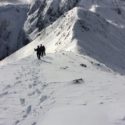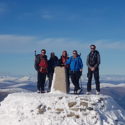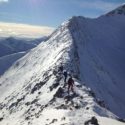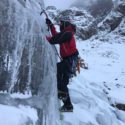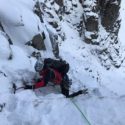On the evening of 26 February 17, 11 members of Air Cadet Organisation’s volunteer staff gathered at the Inchree lodges in Onich in the Western Highlands of Scotland with the objective of furthering their knowledge and experience of the British mountain environment. Two members of the team would be undertaking a Joint Services Winter Climbing Foundation course with the remainder undertaking 5 days of walking in the winter mountain environment. The expectation within the team for quality days out was relatively low as the winter thus far had been relatively poor with minimal snow cover. The drive up from the National Air Cadet Centre in Windermere had further dampened expectations for winter conditions due to the high levels of wind and rain encountered in the borders and central highland regions.
The first evening was spent ensuring that everyone was appropriately equipped for their activity and weather and avalanche forecasts were studied to decide on appropriate venues for the following day’s activity. With a good weather forecast for the following day but an unknown amount of snow being put down on the mountains overnight the chosen locations of Stob Coire nan Lochan and Sron na Larig in the Larig Elide allowed enough flexibility for the groups to alter plans according to the conditions that they found whilst also practicing some essential safety skills as part of their journey.
The Monday dawned with a beautiful blue sky and it was clear that the previous night’s rain had been put down as snow above 400m. This made for some good opportunities to discuss route choice in the winter environment to avoid both potentially avalanche prone slopes and the requirement to wade through deep snow to make progress. Groups also took the opportunity to look at the use of transceivers, shovels and probes to increase the chances of finding victims caught up in an avalanche. After returning back to the hostel with sunburned faces the group made plans to further explore the Glencoe hills, taking advantage of the stable weather forecast. Both the climbing and walking teams studies the avalanche forecast with the climbers deciding to head to Buachaille Etive Mhor and the walkers heading to the neighbouring Buachaille Etive Beag.
The day dawned overcast but steadily the cloud lifted to treat the groups to more blue sky weather. The climbers were treated to fine mixed climbing conditions with frozen turf and un-iced cracks allowing the students to practice mixed climbing movement techniques and put avalanche knowledge to good use assessing the notorious descent in to Coire na Tulaich. The Walking group made good progress on Buchaille Etive Beag reaching both the Munro of Stob Dubh and the top of Stob Coire Raineach and using the terrain heading northeast of here to practice navigation in winter. All of the group were holders on the summer Mountain Leader award and they looked at choosing the appropriate technique when the smaller terrain features are obliterated by snow. During the evening all members of the expedition visited the Clachaig Inn to hear Local Mountain Guide Mike Pescod deliver a lecture on human factors in decision making.
For Wednesday the forecast remained good and the walkers decided to start exploring the Mamores. Starting from the Mamore Lodge Hotel the group headed up to Stob Coire a’ Chairn and made their way west along the ridge to Am Bodach dropping down from the col west of the summit to return to the hotel via the West Highland Way path. The rocky ascent to the summit of Am Bodach required careful footwork and provided an opportunity to practice the steady movement that would be required for Flt Lt Martin Christleib’s stated aim for the week of an ascent of Ben Nevis via the Carn Mor Dearg arête. The climbing group headed in to Stob Coire nan Lochan to take advantage of the continuing good mixed climbing conditions. Some careful snow assessment and decision making was required on the slopes approaching the routes and with numerous other climbing parties intending on attempting the route that the team had chosen a hasty change of plans occurred. Moving on to a more obscure area of the crag and upping the grade slightly to IV 5 allowed the group to further develop their understanding of the Scottish winter climbing grading system.
The planning and forecast interpretation was now being managed more and more by the students on the courses with less input from the experienced instructors. The walkers made plans to return to the Mamores on Thursday but this time with a northern approach from Glen Nevis to Mullach nan Coirean followed by an eastward journey to Stob Ban descending back to Glen Nevis from the col east of here. The forecast for the day involved higher westerly winds and snow showers and the journey east would take advantage of the winds assistance. CI Scott Watson’s feet and ankles were feeling somewhat battered from his stiff climbing boots so he took advantage of an opportunity to ‘rest’ them by joining the walking group for a full winter hill day, a fairly tenuous definition of resting in anyone’s book. The remainder of the climbers headed to Ben Nevis in search of some ice to practice movement and the use of ice protection. The consistently below freezing summit temperatures meant that ice was scarce and coupled with the previous day’s westerly winds the group was required to move around the north face carefully to avoid avalanche prone slopes in their search for a good training location. After exploring Number 3 gully buttress and Waterpipe Gully the group found some good short ice pitches in the Gulch that were ideal for learning ice screw placement and movement techniques.
The final day of the exercise saw the culmination of learning for both the walking and climbing teams. The climbers now felt able to take on the challenge of leading an appropriate winter climb, deciding to head back to Stob coire nan Lochan for an attempt on Dorsal Arete. Both members of the team were able to take turns leading the route with minimal input from their instructor, displaying a good understanding of how to safely approach the cliff, manage the ropework and move effectively over the mixed terrain to make a good ascent of the route. The walkers decided that the low winds and clear skies forecast for the final day would provide good conditions for an ascent of Ben Nevis via the Carn Mor Dearg arête. The decision was made to use the Ski Gondola up to 600m on the neighbouring hill of Aonach Mor to be able to approach the arête from the Allt Daim valley and extend the ridge walking experience by approaching Carn Mor Dearg summit via its east ridge. This provided plenty of opportunities to study the effects of the westerly winds on the transportation of snow and the build-up of windslab that could lead to a group being caught up in an avalanche if they made inappropriate route choices. There was evidence of several natural avalanches having occurred in the valley that provided further opportunities for education. The east ridge of Carn Mor Dearg provided a good opportunity to practice movement in crampons before committing to the more exposed traverse of the arête with the final slope to the summit revealing a fine view of almost the entire Highlands of Scotland capped in snow against the blue sky.
The team would like to thank the Ulysses Trust and the RAF Charitable Trust for their support with this exercise. All members of the team have increased their understanding on the winter mountains and the decision making process required to remain safe in the environment. Several of the participants are now in a position to undertake the Winter ML training course with one member of the team moving forward with their stated aim of registering for the International Mountain Leader scheme.

